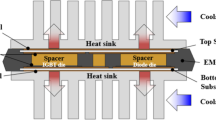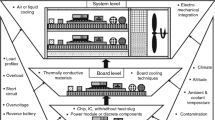Abstract
This paper proposes the use of a perforated pin for a SiC power module heatsink in automotive applications. Both simulations and experiments demonstrate how the proposed new pin design can enhance cooling performance. We extensively investigate the shapes and locations of pin–fin structures, commonly used for power module cooling. However, due to limitations in geometrical optimization for improving cooling performance, we introduce a novel concept: the perforated pin. Ansys Fluent is utilized to conduct a preliminary analysis of the new pin design prior to prototyping and testing with a specially designed apparatus. Our proposed design is compared with three conventional alternatives: a standard cuboidal pin–fin (reference), a cuboidal pin–fin after geometric optimization, and cylindrical pin–fin cooling structures. The results reveal that the proposed design reduces the maximum device temperature while slightly increasing pressure loss. Notably, the pressure loss increment of our design is only 36.6% compared to the geometrically optimized cuboidal pin–fin, which exhibits a 151% increase in pressure loss alongside improved cooling performance.















Similar content being viewed by others
References
Chen, H., Hu, T., Li, M., Zhao, Z.: Cu@Sn core-shell structure powder preform for high-temperature applications based on transient liquid phase bonding. IEEE Trans. Power Electron. 32(1), 441–451 (2017)
Yoon, S.W., Glover, M.D., Shiozaki, K.: Nickel–tin transient liquid phase bonding toward high-temperature operational power electronics in electrified vehicles. IEEE Trans. Power Electron. 28(5), 2448–2456 (2013)
Lee, T.-Y.: Design optimization of an integrated liquid-cooled IGBT power module using CFD technique. IEEE Trans. Compon. Package Manuf. Technol. 23(1), 55–60 (2000)
Dupont, L., Avenas, Y., Jeannin, P. -O.: Comparison of junction temperature evaluations in a power IGBT module using an IR camera and three thermo-sensitive electrical parameters. In: IEEE Applied Power Electronics Conference and Exposition (APEC), Orlando, pp. 182–189 (2012)
Gillot, C., Schaeffer, C., Massit, C., Meysenc, L.: Double-sided cooling for high power IGBT modules using flip chip technology. IEEE Trans. Compon. Package Technol. 24(4), 698–704 (2001)
Jeon, J., Seong, J., Lim, J., Kim, M.K., Kim, T., Yoon, S.W.: Finite element and experimental analysis of spacer designs for reducing the thermomechanical stress in double-sided cooling power modules. IEEE Trans. Emerg. Sel. Topics Power Electron. 9(4), 3883–3891 (2021)
Stippich, A., Battefeld, L. J., Doncker, R. W. D.: Integrated cooling channels in direct bonded copper substrate for silicon carbide MOSFETs. In: PCIM Europe, Nuremberg, pp. 1–8 (2018)
Chen Y., et al.: Thermal characterization analysis of IGBT power module integrated with a vapour chamber and pin–fin heat sink. In: PCIM Europe, Nuremberg, pp. 1–8 (2017)
Joshi, S.N., Lohan, D.J., Dede, E.M.: Two-phase performance of a hybrid jet plus multipass microchannel heat sink. ASME. J. Thermal Sci. Eng. Appl. 12(1), 011019 (2020)
Uhlemann, A., Hymon, E.: Directly cooled HybridPACK power modules with ribbon bonded cooling structures. In: PCIM Europe, Nuremberg, pp. 1–6 (2018)
Yang, D., Wang, Y., Ding, G., Jin, Z., Zhao, J., Wang, G.: Numerical and experimental analysis of cooling performance of single-phase array microchannel heat sinks with different pin-fin configurations. Appl. Therm. Eng. 112, 1547–1556 (2017)
Nguyen, N.P., Maghsoudi, E., Roberts, S.N., Kwon, B.: Shape optimization of pin fin array in a cooling channel using genetic algorithm and machine learning. Int. J. Heat Mass Transf. 202, 123769 (2023)
Hitachi, T., Gohara, H., Nagaune, F.: Direct liquid cooling IGBT module for automotive applications. Fuji Electr. Rev. 58(2), 55–59 (2012)
Kim, M. -K., Yoon, Y. -D., Yoon, S. W.: Actual maximum junction temperature estimation process of multichip SiC MOSFET power modules with new calibration method and deep learning. IEEE Trans. Emerg. Sel. Topics Power Electron. (2022)
Lim, J., Jang D. K., Yoon, S. W.: Novel temperature calibration method of E-mode and D-mode GaN power modules considering dynamic on-resistance. IEEE Trans. Ind. Electron. (early access).
Acknowledgements
This work was supported by the National Research Foundation of Korea(NRF) grant funded by the Korea government(MSIT) (No. 2023R1A2C2006661 and No. RS-2023-00207865).
Author information
Authors and Affiliations
Corresponding author
Ethics declarations
Conflict of interest
On behalf of all authors, the corresponding author states that there is no conflict of interest.
Rights and permissions
Springer Nature or its licensor (e.g. a society or other partner) holds exclusive rights to this article under a publishing agreement with the author(s) or other rightsholder(s); author self-archiving of the accepted manuscript version of this article is solely governed by the terms of such publishing agreement and applicable law.
About this article
Cite this article
Pyun, S., Cho, S. & Yoon, S.W. Analysis of perforated pin design use in automotive SiC power module heatsink. J. Power Electron. 23, 1888–1895 (2023). https://doi.org/10.1007/s43236-023-00707-y
Received:
Revised:
Accepted:
Published:
Issue Date:
DOI: https://doi.org/10.1007/s43236-023-00707-y




